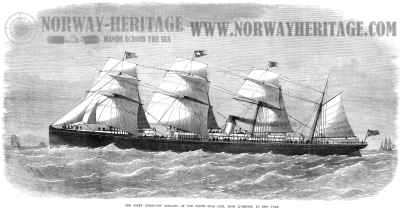 Adriatic (1), White Star Line steamship Support Norway Heritage: Purchase a copy |
The Adriatic was of the so called
Oceanic class. The hull, framework, masts, yards, decks, and whole ship, except the floors and furniture, were made of iron. Additional strength was given by six iron bulkheads from the keel to the main-deck, dividing the ship into seven compartments. She had four masts, and the height of the mainmast was 150 feet. The manner in which the yards were constructed was similar to that in the
Republic. The yards were movable up and down the
masts, and crosstrees had been discarded. This plan of making the yards, so that they moved upward and downward, was a new invention of Messrs. Harland and Wolff. The labour involved in moving the yards would have been considerable had not provision been made for it by steam-winches. There were six steam-winches which were also used for lifting cargo, setting sail, and other operations which required great power. The windlass was also worked by steam. The steering apparatus was fixed amidships, with the steam steering-wheel of Foresters and Company, of Liverpool. In case of accident, a complete steering-gear was also fitted up at the stern. It was possible to have communication between the stern and the bridge by Gisborne's telegraph. The engine-room, situated amidships, contained four
compound engines by Maudslay and Field, of London. There were twenty-four furnaces and four
cylinders. The cylinders were of the nominal collective horse-power of 600, working up to 3000 indicated horse-power. The single screw had a diameter of 22 ft. 6 in., with four steel blades. This gave the screw a circumference of more than 66 ft.; and, as it performed fifty revolutions per minute, the rate at which it travelled was not less than 1000 yards per minute. This was the largest screw in the merchant service at the time. Over the forepart of the ship a vast iron hurricane-deck had been constructed, which not only prevented the waves of a
storm washing over the main-deck, but also added to the strength of the vessel. From the hurricane-deck to the stern extend two promenades, one on each side; a portion of these was sheltered from the rain by a lateral extension of the upper deck. In the aft part of the main-deck a steam fire-engine had been erected, which could at once be brought into action. On the upper deck above the saloon were water-tanks, from which pipes were laid on to the sleeping- apartments. The ventilation was ample, there was twenty fair-weather ventilators in the saloon, and twenty foul-weather ventilators, which latter could not be closed; in the sleeping and other portions of the saloon-passengers' quarters there were about a hundred fair-weather and as many foul-weather ventilators, so that, under all circumstances, the utmost attention had been given to the means for introducing fresh air. The decorations, fittings, and furniture were very handsome, and all was conveniently arranged. The ship was capable of accommodating 1150 passengers-150 in the saloon and 1000
steerage. The saloon, the ladies' boudoir, the smoking-room, bar, barber's shop, and officers' rooms, the sleeping-rooms, and the engine-house, were all lighted by gas, there being 300 burners altogether. She was fitted by Porter & Co for gas generated by oil, in place of candles and oil-lamps. There were 30 jets in the saloon. The gas was made from an oil which was not explosive, and a continuous supply could be kept up for any length of time, as the manufacture took place on board the ship. However, the idea was a failure due to leaks caused by vibrations in the ship. [Info derived from an article in the Illustrated Lodon News 1872 and other sources]
 Adriatic (1), White Star Line steamship Support Norway Heritage: Purchase a copy |